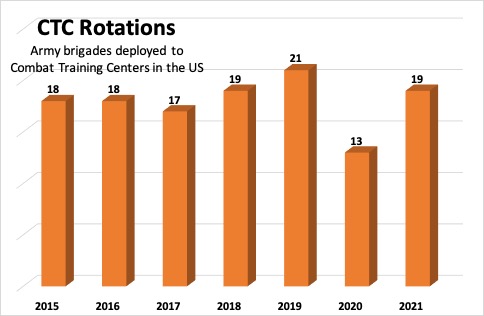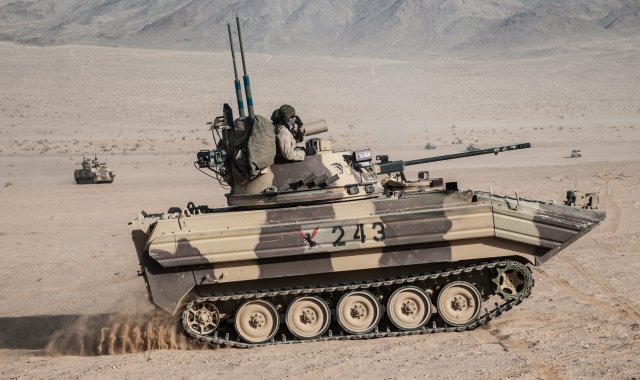
Note: 18 rotations were planned for 2020, but five were cancelled due to COVID-19.
WASHINGTON: The Army has cancelled a National Guard brigade’s planned deployment to Combat Training Center wargames next year, but the other 19 brigade rotations to Fort Irwin and Fort Polk will proceed as planned.
We don’t have data for the third CTC, the Joint Multinational Readiness Center in Germany, because it falls under a different command.
The intense exercises at the CTCs are the gold standard for Army training, as Gen. James McConville, the chief of staff, said earlier this week at the annual AUSA conference. How many units get to go to CTC is not only significant in itself. It’s often seen as a proxy for Army readiness writ large. But the wargames and the work-up beforehand are grueling, and Army leaders are looking to streamline training to reduce stress on their heavily burdened soldiers.

An Opposing Force (OPFOR) vehicle at the Fort Irwin, Calif. National Training Center, mocked up to look like an enemy machine.
So how do next year’s number hold up to history? The 19 rotations remaining for 2021 is above the 18 that were planned for 2020, and five of those had to be cancelled due to COVID, Army staffers told me. In fact, 19 is slightly above the average for the five-year period pre-COVID, 2015-2019. But 19 is slightly below the pre-COVID peak, the 21 rotations in 2019.
Not all rotations are created equal, however. Just because a brigade is going to “the box” – the designated territory where simulated battles are held – that doesn’t mean the entire brigade is going. Army Forces Command, which oversees stateside training, always has the option to deploy only part of a brigade, instead of the entire unit, if it’s deemed necessary to reduce stress on the troops.
That’s an option which Army leaders recently said should be taken for at least some units. “To further reduce the demands of training for and supporting CTC rotations, not all Brigade Combat Teams will deploy all of their battalions into ‘the box,’” wrote Army Secretary Ryan McCarthy, Gen. McConville, and Sergeant Major of the Army Michael Grinston in an Oct. 13 post on Army.mil.
Any such decision, however, will be made on a case-by-case basis by the commanders involved, a Forces Command spokesman told me. “The structure of the remaining units participating in the FY 2021 CTC rotations have not changed,” Col. James Rawlinson wrote in an email. “These rotations are shaped during dialogues between the senior unit commanders at Corps and Divisions, the respective CTC Commander, and the FORSCOM CG… the respective CTC would tailor the rotation based on the guidance the FORSCOM CG provides.”
McCarthy, McConville, and Grinston also said they would cancel some of the intense workups that brigades were historically required to do at home base before they were considered ready for the CTCs. “To reduce OPTEMPO [operational tempo],” they wrote, “we will minimize gated training requirements and eliminate the requirement to conduct brigade and battalion Live Fire Exercises and Field Training Exercises prior to a CTC rotation.”
Why do units prepare so intensively for their CTC tours? For most soldiers, Combat Training Center exercises are the greatest test they’ll face short of battle. A “rotation” to the National Training Center (NTC) at Fort Irwin – for armor – or the Joint Readiness Training Center (JRTC) at Fort Polk – for infantry – is traditionally the peak of a brigade’s training cycle, a kind of graduation exercise before the unit is certified as ready to deploy to war. During the decades of counterinsurgency in Afghanistan and Iraq, the CTCs were set up with mock villages, inhabited by contracted roleplayers acting as civilians and guerillas, but lately they’ve refocused on simulating a high-tech threat like that of Russia.
Army leaders sent seemingly conflicting signals on CTCs this week during the annual AUSA conference, and I’ve spent the last few days working with Army staff to get the story straight.
While the Army is seeking to reduce the stress on its soldiers, Gen. McConville said at AUSA on Tuesday, “there’s no intent to reduce Combat Training Center rotations for units.”
But later that same day, the FORSCOM commander, Gen. Michael Garrett, said the pace of CTC rotations in the last few years before COVID was “certainly not sustainable” and would come down.
So which is it? Well, if you look at the data the Army provided me, you can find support for either statement, depending on how narrowly or broadly you make your comparison.
CTC rotations had been trending upward before COVID, peaking at 21 last year: Presumably it’s this increasing pace that Garrett considers “not sustainable.” The data also show that post-COVID rotations will not return to that pre-COVID peak, as Garrett said, at least not in 2021.
What about McConville’s statement, that there’s “no intent” to reduce rotations? Well, the number of rotations in 2021 is being reduced, by one, compared to the previous plan. But if you look at the wider context of 2015-2020, not just one year, then the 19 rotations remaining in ’21 is above average – in fact, it’s tied for second highest. In that bigger picture, CTC rotations are not being reduced, as the Chief of Staff said.
What happens after 2021? Nobody knows. With trillions spent on COVID, the entire federal government faces a probable budget crunch, and next month’s elections could put Democrats – traditionally quicker to cut defense spending than Republicans – in control of the White House and Congress. Even if the budget were to stay flat, the need to balance readiness and modernization still has the Army working on at a wholesale overhaul of how it trains, equips, and deploys its units, what it calls the Regionally Aligned Readiness & Modernization Model (REARRM). CTC exercises will remain the “gold standard” for wargames, but the number the Army decides it needs – and can afford – may well change.






















